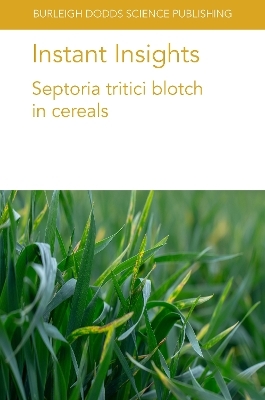
Instant Insights: Septoria Tritici Blotch in Cereals
Burleigh Dodds Science Publishing Limited (Verlag)
978-1-80146-319-5 (ISBN)
The first chapter reviews the various methods for managing septoria tritici blotch (STB), from the the use of fungicides to marker-assisted breeding for increased resistance to STB. It also surveys research on the molecular basis of host-pathogen interactions in STB.
The second chapter reviews current research on the main fungal diseases affecting barley, focussing on biotrophic foliar diseases, such as stem rust and powdery mildew, as well as necrotrophic diseases, such as septoria tritici blotch and fusarium head blight. The chapter also discusses the implications for achieving sustainable resistance to the pathogens responsible for these diseases.
The third chapter addresses advances in understanding the epidemiology of septoria tritici blotch in the major cereal crops. The chapter also reviews the taxonomy and life cycle of Zymoseptoria tritici - the cause of septoria tritici blotch, as well as the economic impact of the pathogen.
The final chapter reviews recent research on genetic resistance loci and breeding strategies based on both conventional and biotechnology-based breeding approaches to achieve durable resistance to septoria tritici blotch infection, whilst simultaneously minimising the risk of grain yield losses.
Dr Stephen B. Goodwin is a Research Plant Pathologist with the Agricultural Research Service of the U.S. Department of Agriculture, with a current focus on Septoria tritici blotch of wheat plus tar spot of maize.
Chapter 1 - Diseases affecting wheat: Septoria tritici blotch: S. B. Goodwin, USDA-ARS, USA; 1 Introduction 2 Use of fungicides for controlling STB 3 Breeding for increased resistance to STB 4 Understanding the molecular basis of the host–pathogen interaction 5 Conclusion and future trends 6 Where to look for further information 7 References
Chapter 2 Fungal diseases affecting barley: Robert S. Brueggeman, Shyam Solanki, Gazala Ameen and Karl Effertz, Washington State University, USA; Roshan Sharma Poudel, North Dakota State University, USA; and Aziz Karakaya, Ankara University, Turkey; 1 Introduction 2 Understanding plant genetic resistance to fungal pathogens 3 Biotrophic foliar diseases: stem rust 4 Leaf rust 5 Stripe rust 6 Powdery mildew 7 Necrotrophic diseases: spot blotch 8 Net blotch 9 Ramularia leaf spot 10 Septoria speckled leaf blotch 11 Scald 12 Fusarium head blight 13 A seed-borne disease: barley stripe 14 Conclusion 15 References
Chapter 3 Advances in understanding the epidemiology of Septoria tritici blotch in cereals: Stephen B. Goodwin, USDA-ARS, USA; 1 Introduction 2 What’s in a name: taxonomy of Z. tritici 3 Life cycle of Z. tritici 4 Mode of nutrition 5 Epidemiology 6 Diagnostics 7 Conclusion and future trends 8 Where to look for further information 9 References
Chapter 4 Advances in breeding techniques for durable Septoria tritici blotch (STB) resistance in cereals: Harsh Raman, NSW Department of Primary Industries, Australia; 1 Introduction 2 Challenges in achieving durable resistance: qualitative and quantitative resistance 3 Molecular marker technologies for genetic mapping of Septoria tritici blotch resistance genes 4 Ways of increasing durability of resistance: planting of varietal mixtures 5 Ways of increasing durability of resistance: deployment of qualitative resistance genes 6 Ways of increasing durability of resistance: pyramiding of qualitative and quantitative resistance genes 7 Ways to increase durability of resistance: manipulation of plant architecture genes and deployment of multiple resistance loci 8 Marker-assisted selection (MAS) and genomic selection (GS) for Septoria tritici blotch resistance breeding 9 The use of genetic transformation and gene editing techniques 10 Conclusion and future trends 11 References
| Erscheinungsdatum | 05.03.2022 |
|---|---|
| Reihe/Serie | Burleigh Dodds Science: Instant Insights |
| Zusatzinfo | Color tables, photos and figures |
| Verlagsort | Cambridge |
| Sprache | englisch |
| Maße | 152 x 229 mm |
| Gewicht | 230 g |
| Themenwelt | Naturwissenschaften ► Biologie ► Botanik |
| Weitere Fachgebiete ► Land- / Forstwirtschaft / Fischerei | |
| ISBN-10 | 1-80146-319-0 / 1801463190 |
| ISBN-13 | 978-1-80146-319-5 / 9781801463195 |
| Zustand | Neuware |
| Informationen gemäß Produktsicherheitsverordnung (GPSR) | |
| Haben Sie eine Frage zum Produkt? |
aus dem Bereich


